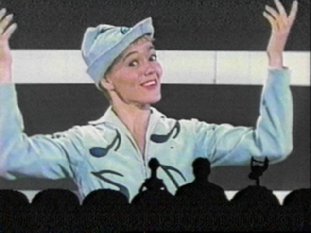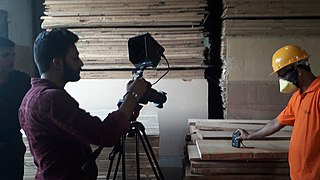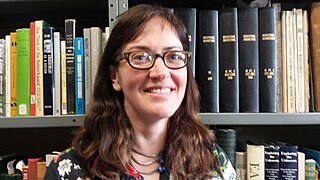Related Research Articles
Social guidance films constitute a genre of educational films attempting to guide children and adults to behave in certain ways. Originally produced by the U.S. government as "attitude-building films" during World War II, the genre grew to be a common source of instruction in elementary and high school classrooms in the United States from the late 1940s to the early 1970s. The films covered topics including courtesy, grammar, social etiquette and dating, personal hygiene and grooming, health and fitness, civic and moral responsibility, sexuality, child safety, national loyalty, racial and social prejudice, juvenile delinquency, drug use, and driver safety; the genre also includes films for adults, covering topics such as marriage, business etiquette, general safety, home economics, career counseling and how to balance budgets. A subset is known as hygiene films addressing mental hygiene and sexual hygiene.

Film preservation, or film restoration, describes a series of ongoing efforts among film historians, archivists, museums, cinematheques, and non-profit organizations to rescue decaying film stock and preserve the images they contain. In the widest sense, preservation assures that a movie will continue to exist in as close to its original form as possible.

Ephemera are transitory creations which are not meant to be retained or preserved. Its etymological origins extends to Ancient Greece, with the common definition of the word being: "the minor transient documents of everyday life". Ambiguous in nature, various interpretations of ephemera and related items have been contended, including menus, newspapers, postcards, posters, plastic champagne glasses, portable classrooms and stickers.
Precious Images is a 1986 short film directed by Chuck Workman. It features approximately 470 half-second-long splices of movie moments through the history of American film. Some of the clips are organized by genre and set to appropriate music; musicals, for example, are accompanied by the title song from Singin' in the Rain. Films featured range chronologically from The Great Train Robbery (1903) to Rocky IV (1985), and range in subject from light comedies to dramas and horror films.
An industrial musical is a musical performed internally for the employees or shareholders of a business to create a feeling of being part of a team, to entertain, and/or to educate and motivate the management and salespeople to improve sales and profits. It can be used to increase staff awareness of public relations, advertising, marketing or corporate image.
In library and archival science, digital preservation is a formal endeavor to ensure that digital information of continuing value remains accessible and usable. It involves planning, resource allocation, and application of preservation methods and technologies, and it combines policies, strategies and actions to ensure access to reformatted and "born-digital" content, regardless of the challenges of media failure and technological change. The goal of digital preservation is the accurate rendering of authenticated content over time. The Association for Library Collections and Technical Services Preservation and Reformatting Section of the American Library Association, defined digital preservation as combination of "policies, strategies and actions that ensure access to digital content over time." According to the Harrod's Librarian Glossary, digital preservation is the method of keeping digital material alive so that they remain usable as technological advances render original hardware and software specification obsolete.
The Prelinger Archives is a collection of films relating to U.S. cultural history, the evolution of the American landscape, everyday life, and social history. It was in New York City from 1982 to 2002 and is now in San Francisco.

Rick Prelinger is an archivist, professor at the University of California, Santa Cruz, writer and filmmaker, and founder of the Prelinger Archives, a collection of 60,000 advertising, educational, industrial, and amateur films acquired by the Library of Congress in 2002 after 20 years' operation.

Mr. B Natural is a short sponsored film produced in 1956 by Kling Film Productions for the C.G. Conn Company, directed by Phil Patton. It is also the name of the film's main character, played by Betty Luster.

Archival science, or archival studies, is the study and theory of building and curating archives, which are collections of documents, recordings and data storage devices.

In library and archival science, preservation is a set of preventive conservation activities aimed at prolonging the life of a record, book, or object while making as few changes as possible. Preservation activities vary widely and may include monitoring the condition of items, maintaining the temperature and humidity in collection storage areas, writing a plan in case of emergencies, digitizing items, writing relevant metadata, and increasing accessibility. Preservation, in this definition, is practiced in a library or an archive by a librarian, archivist, or other professional when they perceive a record is in need of maintenance.
An orphan film is a motion picture work that has been abandoned by its owner or copyright holder; also, any film that has suffered neglect.
Digital curation is the selection, preservation, maintenance, collection and archiving of digital assets. Digital curation establishes, maintains and adds value to repositories of digital data for present and future use. This is often accomplished by archivists, librarians, scientists, historians, and scholars. Enterprises are starting to use digital curation to improve the quality of information and data within their operational and strategic processes. Successful digital curation will mitigate digital obsolescence, keeping the information accessible to users indefinitely. Digital curation includes digital asset management, data curation, digital preservation, and electronic records management.
The Association of Moving Image Archivists (AMIA) is a 501(c)(3) not-for-profit organization established to advance the field of moving image archiving by fostering cooperation among individuals and organizations concerned with the acquisition, description, preservation, exhibition and use of moving image materials.

An industrial video is a video that targets “industry” as its primary audience. An industrial video is a type of sponsored film which prioritizes pragmatism over artistic value. While the primary purpose of an educational film is to inform an audience, the purpose of an industrial video can vary depending on the client.
The Texas Archive of the Moving Image (TAMI) is an independent 501(c)(3) organization founded in 2002 by film archivist and University of Texas at Austin professor Caroline Frick, PhD. TAMI's mission is to preserve, study, and exhibit Texas film heritage. The organization has three main projects: the TAMI Online Collection, the Texas Film Round-Up, and Teach Texas. Its offices are located in Austin, Texas.
FOCAL International is the trade association representing stock footage companies, post-production facilities and individuals involved in the use of footage, still images and audio in all forms of media production. It represents more than 300 companies and individuals involved in media production, asset management, preservation of historical archives, film restoration and post-production.
Howard Besser is a scholar of digital preservation, digital libraries, and preservation of film and video. He is Professor of Cinema Studies and the founding director of the NYU Moving Image Archiving and Preservation Program ("MIAP"), a graduate program in the Tisch School. Besser also works as a Senior Scientist at New Your University's Digital Library Initiative. He conducted extensive research in image databases, multimedia operation, digital library, and social and cultural influence of the latest Information Technology. Besser is a prolific writer and speaker, and has consulted with many governments, educational institutions, and arts agencies on digital preservation matters. Besser researched libraries' new technology, archives, and museums. Besser has been actively contributing at the international level to build metadata and upgrade the quality of the cultural heritage community. He predominantly, he focused on image and multimedia databases; digital library aspects ; cultural and societal impacts of information technology, and developing new teaching methods through technology such as web-based instructions and distance learning. Besser was closely involved in development of the Dublin Core and the Metadata Encoding and Transmission Standard (METS), international standards within librarianship.

Last Clear Chance is a 1959 American short film produced and directed by Robert Carlisle. Sponsored by Union Pacific Railroad, Last Clear Chance is a high school safety film intended to warn young drivers to be careful at railroad crossings. The film's cast consists of William Boyett, Harold Agee, Mrs. Harold Agee, Tim Bosworth, William Agee, Christine Lynch, and Lou Spraker. Written by Leland Baxter, the film was shot in parts of Idaho. Wondsel, Carlisle & Dunphy Inc, based in New York City, served as the film's production company.

Megan Prelinger is a cultural historian and archivist. She is the co-founder of the Prelinger Library in San Francisco and author of two books: Another Science Fiction: Advertising the Space Race 1957–1962 and Inside the Machine: Art and Invention in the Electronic Age.
References
- ↑ EPHEMERA: The Prelinger Archives (March 2013 Edition) on Vimeo
- 1 2 3 Prelinger, Rick (2006), The Field Guide to Sponsored Films, San Francisco, California: National Film Preservation Foundation , retrieved 6 February 2011
- ↑ Learning to Love Sponsored Films|Arts & Culture|Smithsonian
- ↑ Labor-Sponsored Film and Working-Class History: The Inheritance (1964) on JSTOR
- ↑ Navigating the well-curated, deeply weird Sponsored Films online archive-The Verge
- ↑ Ephemeral Films by Rick Prelinger on Vimeo
- ↑ EPHEMERA: POPULUXE on Vimeo